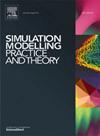Adversarial domain adaptation based on contrastive learning for bearings fault diagnosis
IF 3.5
2区 计算机科学
Q2 COMPUTER SCIENCE, INTERDISCIPLINARY APPLICATIONS
引用次数: 0
Abstract
Accurate fault diagnosis of machines is crucial for increasing efficiency, reducing maintenance costs, and preventing catastrophic consequences.While data-driven methods have shown promise in fault diagnosis, most existing models frequently encounter challenges in achieving satisfactory results in industrial fault diagnosis due to varying working conditions. Studies on domain adaptation have made significant contributions to addressing this problem. However, most of these methods concentrate on aligning the inter-domain distributions, whereas the degradation of intra-domain classification performance is overlooked, resulting in confusion at the class boundaries of the target domain during cross-domain diagnosis. To address this issue, a self-supervised domain contrastive discrimination network (SDCDN) is proposed for bearing fault diagnosis under variable working conditions. The proposed method takes the data from both the source and target domains as input for contrastive learning training. Through self-supervised learning, the feature enhancer is trained to capture domain-contrastive features and effectively distinguish the target category. By aligning the distribution of the source and target domains through adversarial learning, the cross-domain diagnosis is achieved without supervision. To validate the effectiveness of the proposed method, six cross-conditional diagnostic tasks are performed on each dataset, utilizing two bearing datasets containing different damage types and a gearbox dataset. The evaluation indicators employed are diagnostic accuracy and computational efficiency. Furthermore, an ablation study is conducted to evaluate the contribution of the domain contrast and discrimination modules. The results demonstrate that the average accuracy of the proposed method is markedly superior to that of the comparison methods for all six cross-domain diagnostic tasks in each of the three datasets, highlighting the superiority of the proposed method.
基于对比学习的对抗域自适应轴承故障诊断
机器的准确故障诊断对于提高效率、降低维护成本和防止灾难性后果至关重要。虽然数据驱动方法在故障诊断中显示出前景,但由于工作条件的变化,大多数现有模型在工业故障诊断中经常遇到难以获得满意结果的挑战。领域适应的研究为解决这一问题做出了重要贡献。然而,这些方法大多集中在对齐域间分布,而忽略了域内分类性能的下降,导致在跨域诊断过程中目标域的类边界出现混乱。针对这一问题,提出了一种用于变工况下轴承故障诊断的自监督域对比判别网络(SDCDN)。该方法将源域和目标域的数据作为对比学习训练的输入。通过自监督学习,训练特征增强器捕获领域对比特征,有效区分目标类别。通过对抗性学习对齐源域和目标域的分布,实现无监督的跨域诊断。为了验证所提出方法的有效性,利用两个包含不同损伤类型的轴承数据集和一个齿轮箱数据集,对每个数据集执行了六个交叉条件诊断任务。评价指标为诊断准确率和计算效率。此外,还进行了消融研究,以评估域对比和识别模块的贡献。结果表明,该方法在3个数据集的6个跨域诊断任务上的平均准确率明显优于对比方法,突出了该方法的优越性。
本文章由计算机程序翻译,如有差异,请以英文原文为准。
求助全文
约1分钟内获得全文
求助全文
来源期刊

Simulation Modelling Practice and Theory
工程技术-计算机:跨学科应用
CiteScore
9.80
自引率
4.80%
发文量
142
审稿时长
21 days
期刊介绍:
The journal Simulation Modelling Practice and Theory provides a forum for original, high-quality papers dealing with any aspect of systems simulation and modelling.
The journal aims at being a reference and a powerful tool to all those professionally active and/or interested in the methods and applications of simulation. Submitted papers will be peer reviewed and must significantly contribute to modelling and simulation in general or use modelling and simulation in application areas.
Paper submission is solicited on:
• theoretical aspects of modelling and simulation including formal modelling, model-checking, random number generators, sensitivity analysis, variance reduction techniques, experimental design, meta-modelling, methods and algorithms for validation and verification, selection and comparison procedures etc.;
• methodology and application of modelling and simulation in any area, including computer systems, networks, real-time and embedded systems, mobile and intelligent agents, manufacturing and transportation systems, management, engineering, biomedical engineering, economics, ecology and environment, education, transaction handling, etc.;
• simulation languages and environments including those, specific to distributed computing, grid computing, high performance computers or computer networks, etc.;
• distributed and real-time simulation, simulation interoperability;
• tools for high performance computing simulation, including dedicated architectures and parallel computing.
 求助内容:
求助内容: 应助结果提醒方式:
应助结果提醒方式:


